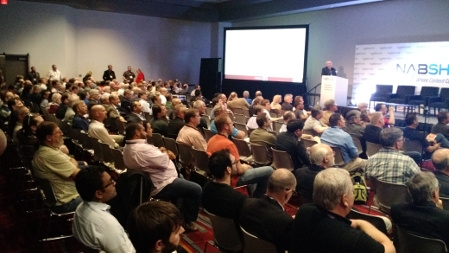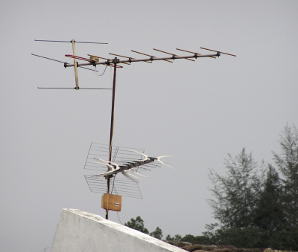April SBE Ennes Workshop to Focus on ATSC 3.0
Part 1
LAS VEGAS—The relationship between broadcasting and technology is a deep one that defines us as broadcast engineers. The NAB Show almost always marks the week when some technology with associated hype turns out to be exciting but without legs. On the other hand, it is also the week when a technology can show up in a corner of the NAB halls, where it is mobbed, and the next thing we know, physical media is dead (or some other equally momentous change). Standards themselves rarely change the course of the industry—unless they do—and then they do in ways most of us could not have imagined.

The SBE's 2016 Ennes Workshop at the NAB Show is scheduled for Saturday, April 16.
When we started planning the Ennes Workshop program for the 2016 NAB Show, Saturday, April 16, it was going to cover progress in the transition from SDI (serial digital interface for video and audio) to video over IP and from hardware to cloud. There is no lack of activity on this accelerating front. At first glance, the Advanced Television Systems Committee’s next-generation ATSC 3.0 standard looked to be a typical sterile standards process with lots of abstract details and few practical applications destined for slow adoption.
But we were wrong. In the process of putting the program together, it became clear that ATSC 3.0 has a great deal of momentum, is impossible to dismiss lightly, and is ready for its first investigational roll-outs. But more than that, ATSC 3.0 fundamentally changes how TV works—including how it makes money. So, this year’s SBE/Ennes program at NAB will be largely about building the ATSC 3.0 station.

WHY ATSC 3.0 HAS MOMENTUM
It’s no secret that not every broadcast engineer thought the digital TV transition under the first ATSC went far enough, was flexible enough, or for that matter was targeted to the future. Still ATSC 1.0 largely “digitized” TV, gave it higher resolution that some thought few would appreciate, program guides that few use and worked great on VHF to reach over the horizon to all those roof-top antennas and living room TVs. ATSC did a great job of what it was preordained to do, but a realistic look at over-the-air TV today reveals that the ATSC 1.0 standard simply can’t do what the business of TV now needs to do. ATSC 3.0 has more to do with survival than sparkle.
The trillion dollar question is: Will the stake holders, viewers, broadcasters, regulators, advertisers and equipment manufacturers all benefit enough to invest in the transition? For ATSC 3.0 to be widely and quickly adopted, the new standard has to be way beyond an incremental improvement—it has to be disruptive. One indication that this might be the case is how the ATSC 3.0 standards process has remained on track, on time and has experienced very little controversy.
Even more telling is that parties that once fought DTV are supporting ATSC 3.0. Some of these are parties who rightly pointed out limitations in ATSC 1.0 that are finally now addressed. Many others are parties that have deep ownership in media. Yes, one can find articles mostly in the non-technical and non-media general press on how current TVs will need to be replaced and the new picture will be better…“but fortunately it’s nothing to worry about for years to come.” I’m afraid it is all too easy and convenient to see ATSC 3.0 as an upgrade in efficiency, quality and reach—all of which is true— and completely miss or at least trivialize how deeply ATSC 3.0 will probably change the TV business.
Let’s start with what ATSC 3.0 is and why the stake holders will be motivated to adopt or reject the transition. But first, we have to look at the world as it has become since the U.S. DTV switch was flipped to full on June 13, 2009. What’s on today’s store display walls are large TVs that noticeably exceed broadcast HDTV’s ability to support with the anticipated picture quality. What’s in the store display cases are devices that are far more mobile than current over-the-air TV can reach.
What’s inside all of these is interactivity that ATSC 1.0’s one-way string of PIDs (packet identifiers—a key part of the DTV data stream) and PSIP, (Program and System Information Protocol—where things like the electronic program guide is located) simply can’t interact with. ATSC 3.0 upgrades broadcast TV to work in a world of multiple often nomadic screens, interactive experiences—with picture and audio quality once reserved for theaters—and the more profitable “advanced advertising” ecosystem.
Get the TV Tech Newsletter
The professional video industry's #1 source for news, trends and product and tech information. Sign up below.

PHY (PHYSICAL LAYER)
The easiest part of ATSC 3.0 to get your head around is the transmission standard. The RF waveform, or Physical Layer (abbreviated and frequently pronounced as the “PHY”) is both capable of larger data payloads (~25 Mbps versus 19.54 Mbps) and greater mobility and penetration.
Even as ATSC 1.0 was being adopted, a substantial number of participants argued that while 8-VSB (8-level Vestigial Sideband, the waveform chosen by ATSC for version one) is a good duplicate of the old analog TV coverage, if mobile devices and multiple screens became popular, it would simply collapse and couldn’t be fixed without complexity and sacrificing already rather limited bandwidth. As you might recall, there were those who argued in favor of orthogonal frequency division multiplexing, or OFDM, the alternative to 8-VSB chosen for most of the world’s broadcast systems and for ATSC 3.0. In the interim, the technology of digital modulation has reached to within a hair of the theoretical maximum performance for such waveforms.
Unlike all but a few other broadcast waveforms, ATSC 3.0 can be adjusted for various levels of quality versus robustness. The original ATSC 1.0 is a “one size fits all,” constant bitrate solution. Attempts to fix this with a backward compatible adaptation (M/H or mobile/handheld) came with business and rights issues, some higher than desirable costs in payload, and it didn’t perform nearly as well as ATSC 3.0’s waveform can. In the same way broadcasters can adjust the quality versus quantity of services in today’s DTV, they will now be able to individually adjust the robustness of various services to tackle either hostile environments or provide more payload for services that demand bigger payloads.
8-VSB, as implemented in North America, has one other Achilles heel; it does not support a single-frequency-network design well. Qualcomm’s MediaFLO took this on in a big way, rethinking how “the distribution network” is designed. If your goal is to have the same kind of reach that the cellular and wireless data networks have, your broadcast distribution network has to look a lot more like a Radio Access Network (RAN) than a big-stick TV transmitter. MediaFLO used a “boomer-booster-and DAS” (distributed antenna system) architecture.
Traditional TV, of course is built around a “boomer,” high-power, tall-tower, transmitter with maybe a few translators to reach communities the main transmitter RF cannot see. With an ATSC 3.0 single frequency network (SFN), the distribution network can start with the traditional tall-tower boomer, that can be considerably more powerful than the 25 kW ERP horizontal and 25 kW vertical that MediaFLO was limited to in order to “carpet bomb” the coverage area with RF. SFN “boosters” are used to push the signal into high population density buildings from close-in sites and distributed antenna systems that push the signal into subways and venues.
Buildings, even at UHF, can present an average 20 dB of attenuation to signals from outside. The power required from a traditional TV transmitter outside of the city to penetrate the buildings where people live and work isn’t just impractical, it is essentially impossible to reach with current technology. While ATSC 1.0 wouldn’t work in even a slow moving car, ATSC 3.0 networks can be designed to reach into moving trains and buses in transportation corridors, not to mention garden-level restaurants and gameside seats, apartments, home kitchens, and backyard pool sides.
The PHY might be easy to isolate into an understandable box, but the standard supports several options to increase payload significantly, from Layered Division Multiplexing to Multiple Input and Multiple Output technology. Time and testing will tell what the practical implementations will be.
In the next part of this article series, we’ll look at the role IP technology will play in ATSC 3.0.
January 12, 2016
“PART II: ATSC 3.0 Brings Flexibility of IP to Broadcast”
The hardest part of the ATSC 3.0 proposed broadcast standard to get one’s head around is probably the IP transport piece.
January 28, 2016
“PART III: Where Does ATSC 3.0 Fit in a Multichannel Universe?”
Two stakeholders that might not be so excited about ATSC 3.0 include the radio access network (RAN) carriers (the providers of wireless data services) and multichannel video programming distributors.
